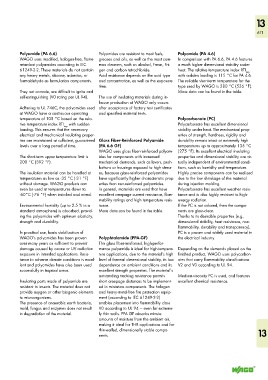Page 613 - Wago_PCB_TerminalBlocksConnectors_Volume2_2015_US
P. 613
13
611
Polyamide (PA 6.6) Polyamides are resistant to most fuels, Polyamide (PA 4.6)
WAGO uses modified, halogen-free, flame- greases and oils, as well as the most com- In comparison with PA 6.6, PA 4.6 features
retardant polyamides according to IEC mon cleaners, such as alcohol, Freon, Fri- a much higher dimensional stability under
61249-2-2. These materials do not contain gen and carbon tetrachloride. heat. The relative temperature index RTI
imp
any heavy metals, silicone, asbestos, or Acid resistance depends on the acid type with sudden loading is 115 °C for PA 4.6.
formaldehyde as formulation components. and concentration, as well as the exposure The reliable short-term temperature for the
time. type used by WAGO is 280 °C (536 °F).
They not corrode, are difficult to ignite and More data can be found in the table.
self-extinguishing (V0 rating per UL 94). The use of insulating materials during in-
house production at WAGO only occurs
Adhering to UL 746C, the polyamides used after acceptance of factory test certificates
at WAGO have a continuous operating and specified material tests.
temperature of 105 °C based on the rela- Polycarbonate (PC)
tive temperature index RTI with sudden Polycarbonate has excellent dimensional
imp
loading. This ensures that the necessary stability under heat. The mechanical prop-
electrical and mechanical insulating proper- erties of strength, hardness, rigidity and
ties are maintained at sufficient, guaranteed Glass Fiber-Reinforced Polyamide durability remain intact at extremely high
levels over a long period of time. (PA 6.6 GF) temperatures up to approximately 135 °C
WAGO uses glass fiber-reinforced polyam- (275 °F). Its excellent electrical insulating
The short-term upper temperature limit is ides for components with increased properties and dimensional stability are vir-
200 °C (392 °F). mechanical demands, such as levers, push- tually independent of environmental condi-
buttons or housings exposed to high stress- tions, such as humidity and temperature.
The insulation material can be handled at es, because glass-reinforced polyamides Highly precise components can be realized
temperatures as low as -35 °C (-31 °F) have significantly higher characteristic prop- due to the low shrinkage of the material
without damage. WAGO products can erties than non-reinforced polyamides. during injection molding.
even be used at temperatures down to In general, materials are used that have Polycarbonate has excellent weather resis-
-60°C (-76 °F) when installed and wired. excellent creepage current resistance, flam- tance and is also highly resistant to high-
mability ratings and high temperature resis- energy radiation.
Environmental humidity (up to 2.5 % in a tance. If the PC is not colored, then the compo-
standard atmosphere) is absorbed, provid- More data can be found in the table. nents are glass-clear.
ing the polyamides with optimum elasticity, Thanks to its desirable properties (e.g.,
strength and durability. dimensional stability, heat resistance, non-
flammability, durability and transparency),
In practical use, basic stabilization of PC is a proven and widely used material in
WAGO’s polyamides has been proven Polyphtalamide (PPA-GF) the electrical industry.
over many years as sufficient to prevent This glass fiber-reinforced, high-perfor-
damage caused by ozone or UV radiation mance polyamide is ideal for high-tempera- Depending on the demands placed on the
exposure in intended applications. Resis- ture applications, due to the material‘s high finished product, WAGO uses polycarbon-
tance to adverse climate conditions is excel- level of thermal dimensional stability, its low ates that carry flammability classifications
lent and polyamides have also been used dependence on ambient conditions and its V2 and V0 according to UL 94.
successfully in tropical areas. excellent strength properties. The material‘s
outstanding tracking resistance permits Medium-viscosity PC is used, and features
Insulating parts made of polyamide are short creepage distances to be implement- excellent chemical resistance.
resistant to insects. The material does not ed in miniature components. The halogen
provide oxygen or other biogenic elements and heavy-metal-free fire protection equip-
to microorganisms. ment (according to IEC 61249-2-2)
The presence of anaerobic earth bacteria, enables placement into flammability class
mold, fungus and enzymes does not result V0 according to UL 94 — even for extreme-
in degradation of the material. ly thin walls. PPA GF absorbs minute
amounts of moisture from the ambient air,
making it ideal for THR applications and for
thin-walled, dimensionally stable compo- 13
nents.

